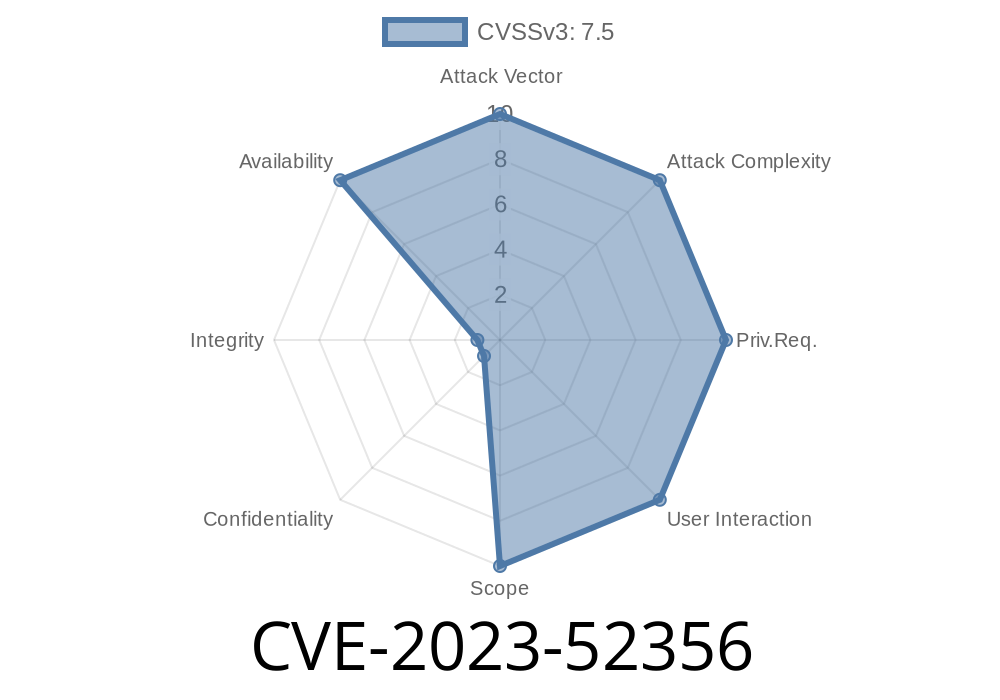A critical vulnerability (CVE-2023-52356) has been identified in the libtiff library, which is widely used for reading and writing TIFF image files. This newly discovered flaw is a segment fault (SEGV) vulnerability that could lead to a heap-buffer overflow, allowing a remote attacker to cause a denial of service (DoS).
In this long-read post, we will delve into the technical details of this vulnerability, examine a code snippet showcasing the exploit, and provide links to original references for a deeper understanding.
Exploit Details
The vulnerability resides in the TIFFReadRGBATileExt() API of the libtiff library. This function is responsible for extracting RGBA pixel data from a specific tile of a TIFF image. When a specially crafted Tiff file is passed to this API, it causes a segment fault (SEGV), leading to a heap-buffer overflow.
The heap-buffer overflow occurs when the memory allocated for the buffer is smaller than the required size for the image data. Consequently, the image data overflows the boundary of the buffer, causing memory corruption and eventually leading to a denial of service (DoS) scenario.
The following code snippet demonstrates the vulnerable API in action
#include <stdio.h>
#include <tiffio.h>
int main(int argc, char* argv[]) {
TIFF* tif;
uint32 width, height;
uint32* buf;
tsize_t bufsize;
if (argc != 2) {
fprintf(stderr, "Usage: %s <input.tiff>\n", argv[]);
return 1;
}
tif = TIFFOpen(argv[1], "r");
if (tif) {
TIFFGetField(tif, TIFFTAG_IMAGEWIDTH, &width);
TIFFGetField(tif, TIFFTAG_IMAGELENGTH, &height);
bufsize = TIFFTileSize(tif);
buf = (uint32*)_TIFFmalloc(bufsize);
if (buf) {
if (TIFFReadRGBATile(tif, , , buf) == ) {
fprintf(stderr, "Failed to read RGBA tile\n");
}
_TIFFfree(buf);
}
TIFFClose(tif);
}
return ;
}
Before we proceed, here are the links to the original references and sources containing further information on CVE-2023-52356:
1. Official CVE-2023-52356 Advisory
2. National Vulnerability Database (NVD) Entry
3. libtiff Official Website
Mitigation
To mitigate this vulnerability, the developers of libtiff must patch the flaw in the TIFFReadRGBATileExt() API by implementing proper bound checks and ensuring sufficient memory allocation for the buffer. Developers utilizing libtiff in their applications should upgrade to the latest version of the library as soon as the fix is released.
Users of applications using the libtiff library should keep their software updated and avoid opening suspicious TIFF files from unknown sources.
Conclusion
The CVE-2023-52356 vulnerability in the libtiff library is a serious flaw that can lead to a heap-buffer overflow and denial-of-service attacks. We hope this long-read post has provided comprehensive information on the technical aspects of the vulnerability, the code snippet demonstrating the exploit, and links to the original references. Please make sure to update your software and stay safe while dealing with TIFF files!
Timeline
Published on: 01/25/2024 20:15:39 UTC
Last modified on: 03/11/2024 13:15:52 UTC
